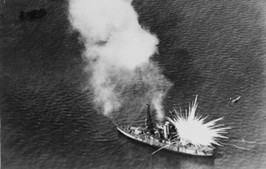
The second phase took place the next morning, and it was a much larger operation including eight Royal Aircraft Factory S.E.5s, armed with 25 lb. bombs, and four Martin NBS-1 bombers with 300 lb. bombs. Two of the bombs hit the deck toward the bow. Three more NBS-1s followed with armor-piercing bombs, though none of these hit the target.
On 25 September 1921, the last round of tests took place. The bombers scored two more near-misses followed by a direct hit. The blast broke her anchor chains, and the battered ship began to drift. The ship remained afloat for another two days before finally sinking in shallow water on 27 September 1921.
Pictured USS Alabama struck by a white phosphorus bomb US Navy Images
